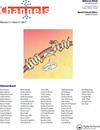The glycosylation of the extracellular loop of β2 subunits diversifies functional phenotypes of BK Channels
IF 3.2
3区 生物学
Q2 BIOCHEMISTRY & MOLECULAR BIOLOGY
引用次数: 8
Abstract
ABSTRACT Large-conductance Ca2+- and voltage-activated potassium (MaxiK or BK) channels are composed of a pore-forming α subunit (Slo) and 4 types of auxiliary β subunits or just a pore-forming α subunit. Although multiple N-linked glycosylation sites in the extracellular loop of β subunits have been identified, very little is known about how glycosylation influences the structure and function of BK channels. Using a combination of site-directed mutagenesis, western blot and patch-clamp recordings, we demonstrated that 3 sites in the extracellular loop of β2 subunit are N-glycosylated (N-X-T/S at N88, N96 and N119). Glycosylation of these sites strongly and differentially regulate gating kinetics, outward rectification, toxin sensitivity and physical association between the α and β2 subunits. We constructed a model and used molecular dynamics (MD) to simulate how the glycosylation facilitates the association of α/β2 subunits and modulates the dimension of the extracellular cavum above the pore of the channel, ultimately to modify biophysical and pharmacological properties of BK channels. Our results suggest that N-glycosylation of β2 subunits plays crucial roles in imparting functional heterogeneity of BK channels, and is potentially involved in the pathological phenotypes of carbohydrate metabolic diseases.β2亚基胞外环的糖基化使BK通道的功能表型多样化
大电导Ca2+和电压激活钾(MaxiK或BK)通道由一个成孔α亚基(Slo)和4种辅助β亚基或仅一个成孔α亚基组成。虽然在β亚基的细胞外环中已经发现了多个n -连接的糖基化位点,但对于糖基化如何影响BK通道的结构和功能却知之甚少。利用位点定向诱变、western blot和膜片钳记录的组合,我们证明了β2亚基细胞外环的3个位点是n -糖基化的(N-X-T/S在N88、N96和N119)。这些位点的糖基化对门控动力学、外向整流、毒素敏感性和α和β2亚基之间的物理关联具有强烈和差异的调节作用。我们构建了一个模型,并利用分子动力学(MD)来模拟糖基化如何促进α/β2亚基的结合,并调节通道孔上方的细胞外腔的尺寸,最终改变BK通道的生物物理和药理学性质。我们的研究结果表明,β2亚基的n -糖基化在BK通道的功能异质性中起着至关重要的作用,并可能参与碳水化合物代谢疾病的病理表型。
本文章由计算机程序翻译,如有差异,请以英文原文为准。
求助全文
约1分钟内获得全文
求助全文
来源期刊

Channels
生物-生化与分子生物学
CiteScore
5.90
自引率
0.00%
发文量
21
审稿时长
6-12 weeks
期刊介绍:
Channels is an open access journal for all aspects of ion channel research. The journal publishes high quality papers that shed new light on ion channel and ion transporter/exchanger function, structure, biophysics, pharmacology, and regulation in health and disease.
Channels welcomes interdisciplinary approaches that address ion channel physiology in areas such as neuroscience, cardiovascular sciences, cancer research, endocrinology, and gastroenterology. Our aim is to foster communication among the ion channel and transporter communities and facilitate the advancement of the field.
 求助内容:
求助内容: 应助结果提醒方式:
应助结果提醒方式:


